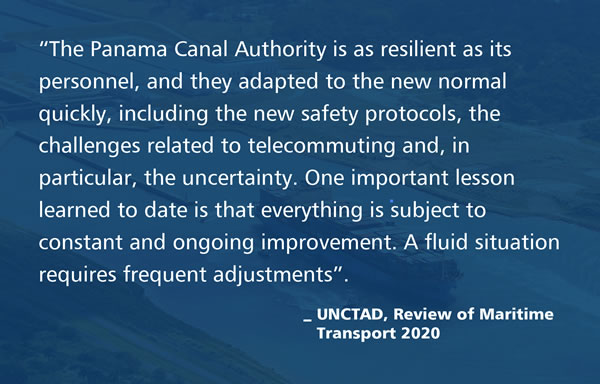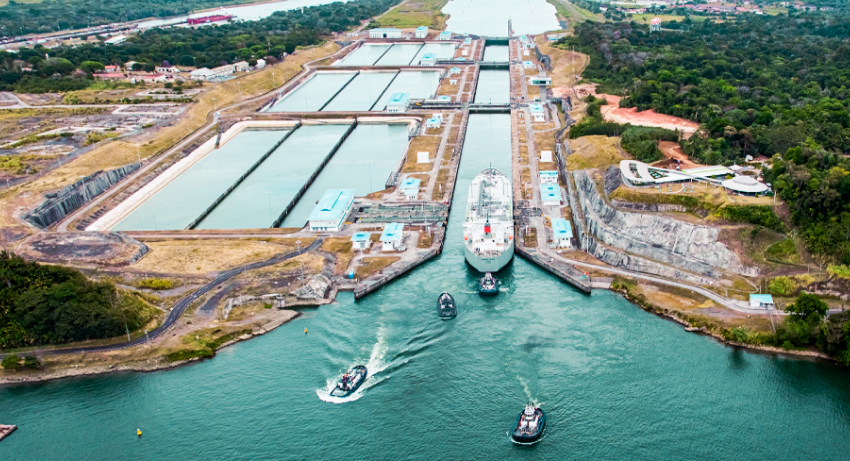In early April, Panama Canal Administrator, Ricaurte Vásquez Morales, pledged to keep the waterway safe and open throughout the pandemic. At the time, global supply chains that relied on the Canal to ferry essential goods were facing disruptions due to country lockdowns that affected ports, factories and consumers, creating an increasing level of uncertainty.
This pledge was not an easy feat since, in normal conditions, approximately 1,200 vessels transit the waterway every month, each requiring several members of the Canal’s transit operations team to board and facilitate its passage through the 50-mile channel. With the COVID-19 health crisis, the health and well-being of Canal workers and client’s crews were at stake. If the contagion went out of control, it could even affect the continuity of Canal operations.
Nonetheless, throughout its 106 years of existence, the Canal has had to adapt and operate through global crises. This experience has enabled it to effectively serve more than 1,700 ports in 160 countries, 24 hours a day, 365 days a year. Hence, beginning in January 2020, the Canal administration implemented safety protocols to guarantee a continuous and uninterrupted service to the communities and economies that depend on it.
“There will be light at the end of the tunnel, and we plan to be ready to support our customers when that day comes,” the Administrator wrote in May. “In the meantime, the Panama Canal will continue to play a critical role in making sure people’s basic needs, including food and medicine, are met every day during the pandemic.”
Today, the Panama Canal marks a promise fulfilled: the waterway has prioritized its team’s health with no traffic interruptions, and it now sees transits nearing pre-pandemic levels.
The Canal’s COVID-19 Roadmap
To ensure its safe, continued service, the Panama Canal prepared early, guided by its century’s worth of experience.
“As operations relied heavily on a culture of safety first, protocols were already in place to handle infectious diseases,” cited UNCTAD’s Review of Maritime Transport 2020. “This regulation was the basis of the initial approach of the Panama Canal Authority to dealing with the pandemic, since it established the procedures to follow prior to the arrival of a vessel and general requirements upon its arrival, as well as protocols for inspections and health measures that included procedures designed for infectious diseases.”
Building on these procedures, the waterway developed new COVID-19 response protocols following the recommendations of the World Health Organization (WHO) and in coordination with the Ministry of Health of Panama (MINSA). These protocols were to be updated constantly to ensure safe operations for both its workforce and customers’ crewmembers.
By March, operations were shifted to working remotely or physically distanced, with on-site personnel limited only to those necessary for projected transits. To minimize the risk of infection and fatigue, the Canal reorganized shifts, arranged private transportation, offered hotel rooms, provided protective equipment, created a COVID response team, took temperatures upon arrival at worksites, disinfected facilities and equipment regularly, and performed serological tests to all the workforce. According to UNCTAD, “vessel arrivals were still high, and putting in place such measures was key in ensuring the safety and availability of the workforce, while maintaining efficient and seamless operations for clients.”
Raising the Standards for Safety
The arrival of Holland America’s Zaandam in late March put these measures promptly to the test. Carrying several ill passengers and crew, the cruise ship had been denied entry by several South American ports before reaching Panamanian waters. To provide support, the Panama Canal began coordinating closely with Holland America and MINSA, which inspected and signed off on each vessel before passage. Together, they facilitated the transfer of healthy passengers and supplies between the Zaandam and Rotterdam, a second Holland America ship that arrived to assist. Then, as an act of humanitarian goodwill, the Panama Canal facilitated the transit of both vessels.
To achieve this objective, Administrator Vásquez Morales, Deputy Administrator Ilya Espino de Marotta and countless other members of the Canal team established extreme safety measures by coordinating with MINSA. They opted to use the waterway’s wider and newer Neopanamax Locks for both transits, while reducing the number of Canal employees required onboard to two pilots who volunteered for the special maneuver.
Through this sense of solidarity, camaraderie and diligence, the Panama Canal shortened the Holland America vessels’ return to the United States by more than two days. According to UNCTAD, “the experience raised the standards for handling similar situations in the future.” It also reaffirmed the waterway’s commitment to continue serving those who relied on the waterway in times of need.

Remaining Safe Amid the Rebound
While the waterway has had cases of COVID-19 among its workforce, none have been tied to, nor affected, its transit operation. The Panama Canal continues to maintain stringent protocols to ensure the safety of its personnel and its customers’ crews.
The Operations team has been back at full staff since May, working in shifts that account for the time and personnel required to adhere to all safety procedures. After months of diligent work, they have observed a rebound in traffic.
Containerships, the Canal’s largest segment, are already returning at rates steadily above projections set in May as the global economy slowly recovers and U.S. retailers restock ahead of the holiday season.
Dry bulk transits now far surpass past projections, as China’s recovering pig farms raise demand for grains, on top of consistent coal shipments from Colombia to Chile and Mexico. LPG, LNG and tanker transits have picked up too, due to favorable market conditions.
To accommodate the recent rise in traffic demand, the Canal has made operational adjustments, increasing the number of operational crews while maintaining its safety protocols, to accommodate more transits per day for vessels that arrive without reservations.
In addition, the Canal has provided relief measures to its customers, which include the deferment of the payment of booking fees to maintain higher liquidity, and the forfeiting of reservation fees for passenger vessels that have been the most affected during this difficult times.
The Panama Canal will always prioritize safety, as it did during the height of the health crisis, adapting as needed to match the fluid situation. This approach and adherence to safety allowed the Canal to remain open without any closures or interruption to traffic throughout the pandemic, enabling customers to continue delivering essential goods around the world. The Panama Canal remains committed to accommodating the world’s economic recovery swiftly, and with all the necessary safety measures still in place.




